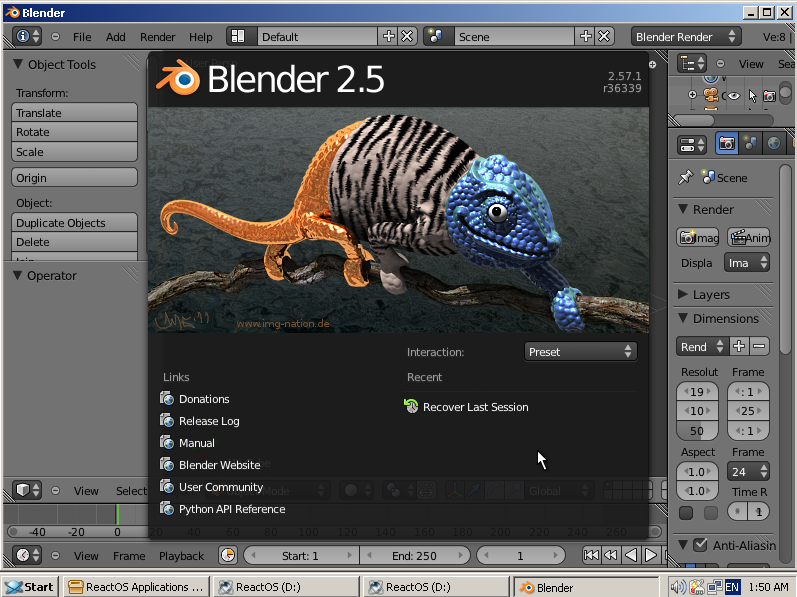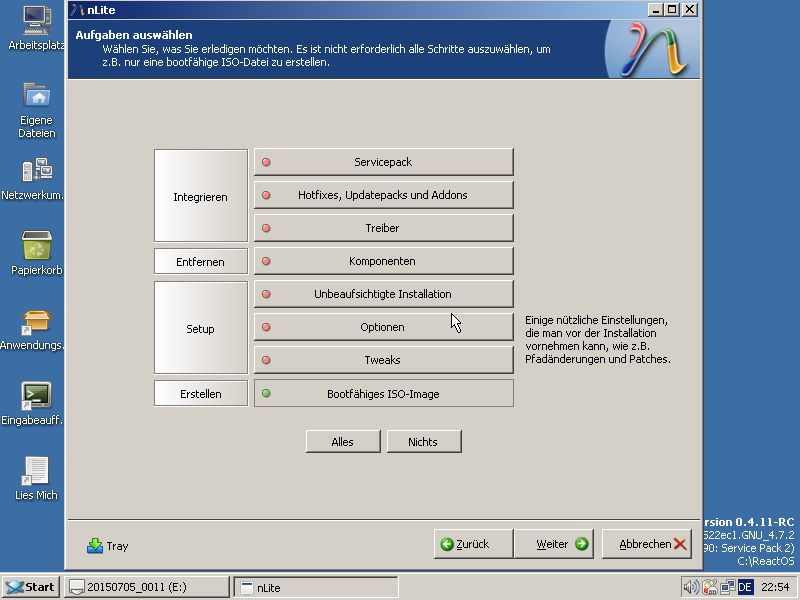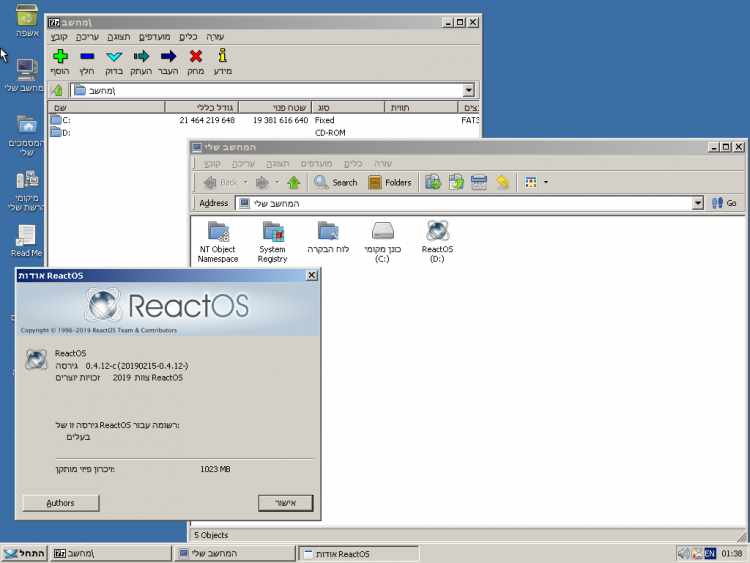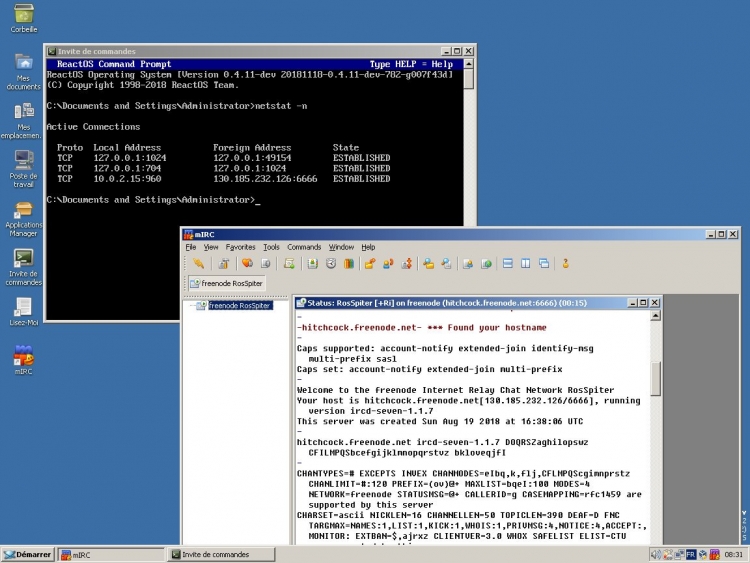ReactOS 0.4.11 - one hundred more applications
Hi, Habr!
I am sure that you have already missed the news from our project! And we did not waste time. The last release of ReactOS was released just some three and a half months ago , and today you can already download and test the next version of our operating system. It fixes 135 bugs, made 984 changes in the source code and beautiful animation of the boot screen .
Download system images | Press release | List of changes | TL; DR | Tests and regression list
')

When working on version 0.4.11, we focused on fixing application compatibility errors, and as a result we were able to increase the number of compatible programs by a good hundred, if not more. At the same time, we once again significantly reduced the number of situations leading to BSODs and system hangs. There are many other changes, but first things first.
The first thing to note is that we podshaman or loader. A loader (LDR) is a component that helps an application to start. He, in particular, reads the manifest files for executable files and libraries, calculates the necessary modules and dependencies for the application being launched, finds them on the disk in the locations of the intended placement and loads them into memory in the correct order.

In previous versions of ReactOS, the MSVC ++ 2005/2008 library hid too well in the system and the loader did not always find them, especially in situations where several manifest files in a row came up in the boot sequence. At Hackfest in Berlin in the summer of 2018, Mark Jensen, at my request, decided to figure it out. And with the release of 0.4.11, the disgrace finally came to an end, and now not one of the necessary libraries can “run away” from the loader. Improved support for manifests made it possible for ReactOS to achieve about a hundred new applications, such as Blender 2.57b, Bumptop, Evernote 5.8.3, Deluge torrent and Quicktime Player 7.7.9.
A grand example of this achievement is the picture above and this screenshot:

On it, you can watch the work of the popular driver installer Snappy Driver (SDI) in ReactOS. Previously, he fell with an error, sometimes caused BSOD, or simply refused to work for the reason described above, but now times have changed ...
A positive indirect effect was that the daredevils no longer have to scour the net for drivers for ReactOS, or you can simply download them all at once on one DVD.
Immediately, I’ll make a reservation that not all drivers from SDI will be installed properly, mostly only network cards, and some video cards. However, we will continue to work on improving this situation.
Earlier in several past releases, ReactOS testers encountered significant difficulties when it came to attempting to use .NET applications. Applications written based on the .NET Framework version 2.0 / 4.0 worked only once , and when closed they caused chaos and forced the system in a state of berserk to cause damage to itself.
In ReactOS version 0.4.11, we finally calculated and overcame the problem that caused this. The point is that from the point of view of the stability of the system, the correct shutdown of the application is just as important as the correct initialization sequence at startup, because when the program is stopped, the resources previously allocated to it are released.
It turned out that the mechanism responsible for the completion of applications in ReactOS often did not expect enough time for the applications to complete their work on their own. This was especially true of applications built on a client-service architecture. A trivial bug fix from Janis Adamopoulos solved this particular problem by instantly adding support for dozens, if not hundreds, of popular dotNET – applications to the ReactOS arsenal.

As an example, a screenshot with nLite 1.4.9.3 - a utility for the "garage" bulkhead of Windows XP distributions.
Finally, it should be recalled that not the whole world uses the standard for displaying text from left to right as English and other languages based on Latin. Many, such as Hebrew and Arabic, use right-to-left orientation. ReactOS support for this type of text display was first officially demonstrated in release 0.4.10, but still continues to be improved. Significant progress was made thanks to the efforts of Baruch Rutman, to adapt the USP10 library and the code to support bidirectional input from Wine to ReactOS. Of course, a lot of work remains to be done, but the nature of the development of an open source project is the application of an iterative approach, with gradual step-by-step changes.

If we talk about the fight against BSODs, it is worth remembering that Mark Jensen revealed a problem with the scrollbar initialization, the correction of which added a whole range of applications to the library of compatible ReactOS programs. Speech for example is about the game Civilization II Multiplayer Gold Edition (32bit) version 1.3, shown in the screenshot below, and other programs like IceChat 7.63.

The network stack was again upgraded, and the process of monitoring and transferring network connections was added. Changes made to TCP / IP components allow the use of netstat, PortExpert and other necessary network applications.

The RAM-disk driver received significant fixes, thanks to which it was possible to fully install the OS over the network using the PXE protocol (previously, only the LiveCD option was possible).

As the operational stability of ReactOS continues to grow, the breadth and depth of testing required also increases, if only because the number of available applications for testing is growing. To this end, Joachim Henze, with his usual methodic and perseverance, worked to ensure the right balance for this release in terms of stability and the appearance of new / improved features. Despite the fact that it is always tempting to make all the most important and significant changes and corrections to the release, it should be remembered that each such change entails a certain degree of risk of regressions. The ability to weigh this risk with an assessment of the likely benefits is what makes quality assurance specialists like Joachim invaluable to any project with rapidly increasing complexity.
In light of the significant improvements in ReactOS and to help potential users better understand the current state of the OS and the degree of support for certain applications, Joachim also restructured the test results page to better present the relevant information. Now you can see not only the general conclusion of the test for each application, but also the details that indicate what led to a specific conclusion, as well as possible “workarounds”, to solve the problem here and now.
You suddenly wanted to put ReactOS for the first time in your life? Be sure to read this installation manual .
Did you like this release? We are waiting for your comments and opinions! Do not forget that you can help the project not only with donations , but also simply by giving it an asterisk on the githaba !
If you like reading my digests on how the development of the ReactOS operating system is progressing, and you want to see such publications more often - you can treat me to a cup of coffee by clicking on the button in the " Support the author " box right now under this article.
I am sure that you have already missed the news from our project! And we did not waste time. The last release of ReactOS was released just some three and a half months ago , and today you can already download and test the next version of our operating system. It fixes 135 bugs, made 984 changes in the source code and beautiful animation of the boot screen .
Download system images | Press release | List of changes | TL; DR | Tests and regression list
')

When working on version 0.4.11, we focused on fixing application compatibility errors, and as a result we were able to increase the number of compatible programs by a good hundred, if not more. At the same time, we once again significantly reduced the number of situations leading to BSODs and system hangs. There are many other changes, but first things first.
- We start! I said - let's start!
The first thing to note is that we podshaman or loader. A loader (LDR) is a component that helps an application to start. He, in particular, reads the manifest files for executable files and libraries, calculates the necessary modules and dependencies for the application being launched, finds them on the disk in the locations of the intended placement and loads them into memory in the correct order.

In previous versions of ReactOS, the MSVC ++ 2005/2008 library hid too well in the system and the loader did not always find them, especially in situations where several manifest files in a row came up in the boot sequence. At Hackfest in Berlin in the summer of 2018, Mark Jensen, at my request, decided to figure it out. And with the release of 0.4.11, the disgrace finally came to an end, and now not one of the necessary libraries can “run away” from the loader. Improved support for manifests made it possible for ReactOS to achieve about a hundred new applications, such as Blender 2.57b, Bumptop, Evernote 5.8.3, Deluge torrent and Quicktime Player 7.7.9.
A grand example of this achievement is the picture above and this screenshot:

On it, you can watch the work of the popular driver installer Snappy Driver (SDI) in ReactOS. Previously, he fell with an error, sometimes caused BSOD, or simply refused to work for the reason described above, but now times have changed ...
A positive indirect effect was that the daredevils no longer have to scour the net for drivers for ReactOS, or you can simply download them all at once on one DVD.
Immediately, I’ll make a reservation that not all drivers from SDI will be installed properly, mostly only network cards, and some video cards. However, we will continue to work on improving this situation.
- So, stop ! Brakes are needed not only for cowards ...
Earlier in several past releases, ReactOS testers encountered significant difficulties when it came to attempting to use .NET applications. Applications written based on the .NET Framework version 2.0 / 4.0 worked only once , and when closed they caused chaos and forced the system in a state of berserk to cause damage to itself.
In ReactOS version 0.4.11, we finally calculated and overcame the problem that caused this. The point is that from the point of view of the stability of the system, the correct shutdown of the application is just as important as the correct initialization sequence at startup, because when the program is stopped, the resources previously allocated to it are released.
It turned out that the mechanism responsible for the completion of applications in ReactOS often did not expect enough time for the applications to complete their work on their own. This was especially true of applications built on a client-service architecture. A trivial bug fix from Janis Adamopoulos solved this particular problem by instantly adding support for dozens, if not hundreds, of popular dotNET – applications to the ReactOS arsenal.

As an example, a screenshot with nLite 1.4.9.3 - a utility for the "garage" bulkhead of Windows XP distributions.
Babel Babylon
Finally, it should be recalled that not the whole world uses the standard for displaying text from left to right as English and other languages based on Latin. Many, such as Hebrew and Arabic, use right-to-left orientation. ReactOS support for this type of text display was first officially demonstrated in release 0.4.10, but still continues to be improved. Significant progress was made thanks to the efforts of Baruch Rutman, to adapt the USP10 library and the code to support bidirectional input from Wine to ReactOS. Of course, a lot of work remains to be done, but the nature of the development of an open source project is the application of an iterative approach, with gradual step-by-step changes.

Buffet of improvements
If we talk about the fight against BSODs, it is worth remembering that Mark Jensen revealed a problem with the scrollbar initialization, the correction of which added a whole range of applications to the library of compatible ReactOS programs. Speech for example is about the game Civilization II Multiplayer Gold Edition (32bit) version 1.3, shown in the screenshot below, and other programs like IceChat 7.63.

The network stack was again upgraded, and the process of monitoring and transferring network connections was added. Changes made to TCP / IP components allow the use of netstat, PortExpert and other necessary network applications.

The RAM-disk driver received significant fixes, thanks to which it was possible to fully install the OS over the network using the PXE protocol (previously, only the LiveCD option was possible).

Sisyphean work "quality department"
As the operational stability of ReactOS continues to grow, the breadth and depth of testing required also increases, if only because the number of available applications for testing is growing. To this end, Joachim Henze, with his usual methodic and perseverance, worked to ensure the right balance for this release in terms of stability and the appearance of new / improved features. Despite the fact that it is always tempting to make all the most important and significant changes and corrections to the release, it should be remembered that each such change entails a certain degree of risk of regressions. The ability to weigh this risk with an assessment of the likely benefits is what makes quality assurance specialists like Joachim invaluable to any project with rapidly increasing complexity.
In light of the significant improvements in ReactOS and to help potential users better understand the current state of the OS and the degree of support for certain applications, Joachim also restructured the test results page to better present the relevant information. Now you can see not only the general conclusion of the test for each application, but also the details that indicate what led to a specific conclusion, as well as possible “workarounds”, to solve the problem here and now.
Final chord
You suddenly wanted to put ReactOS for the first time in your life? Be sure to read this installation manual .
Did you like this release? We are waiting for your comments and opinions! Do not forget that you can help the project not only with donations , but also simply by giving it an asterisk on the githaba !
If you like reading my digests on how the development of the ReactOS operating system is progressing, and you want to see such publications more often - you can treat me to a cup of coffee by clicking on the button in the " Support the author " box right now under this article.
Source: https://habr.com/ru/post/442486/
All Articles